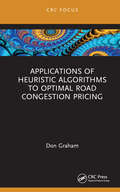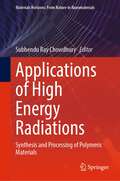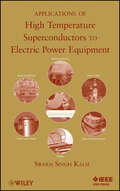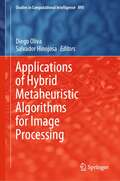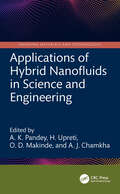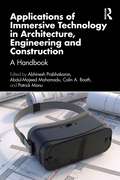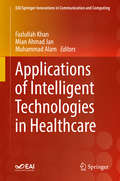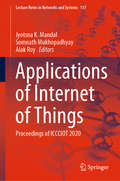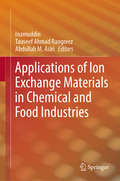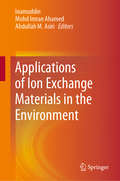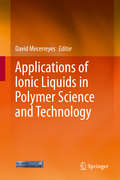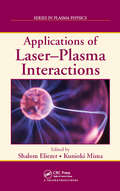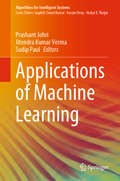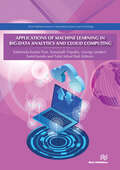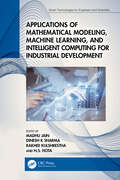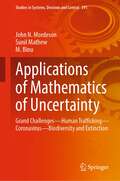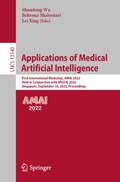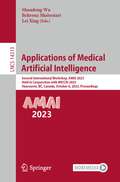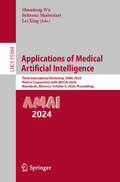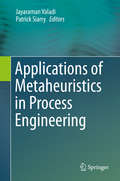- Table View
- List View
Applications of Heuristic Algorithms to Optimal Road Congestion Pricing
by Don GrahamRoad congestion imposes major financial, social, and environmental costs. One solution is the operation of high-occupancy toll (HOT) lanes. This book outlines a method for dynamic pricing for HOT lanes based on non-linear programming (NLP) techniques, finite difference stochastic approximation, genetic algorithms, and simulated annealing stochastic algorithms, working within a cell transmission framework. The result is a solution for optimal flow and optimal toll to minimize total travel time and reduce congestion. ANOVA results are presented which show differences in the performance of the NLP algorithms in solving this problem and reducing travel time, and econometric forecasting methods utilizing vector autoregressive techniques are shown to successfully forecast demand. The book compares different optimization approaches It presents case studies from around the world, such as the I-95 Express HOT Lane in Miami, USA Applications of Heuristic Algorithms to Optimal Road Congestion Pricing is ideal for transportation practitioners and researchers.
Applications of High Energy Radiations: Synthesis and Processing of Polymeric Materials (Materials Horizons: From Nature to Nanomaterials)
by Subhendu Ray ChowdhuryThis book presents the applications of high-energy beam radiation for synthesis and processing of polymeric materials. It addresses fundamental nature of high energy i.e., ionizing radiations and interaction with monomers and polymers leading to a wide variety of products such as tyres, textiles, shape memory polymers, polymers for aviation and space applications, polymeric biomaterials and natural rubber latex. It discusses general principles and techniques of preparation of polymeric materials including polymer blends, composites and nanocomposites. It also includes the topic of radiation-assisted recycling of polymers through breaking of covalent bonds. This book will be useful for students, researchers and professionals in the areas of polymers science and technology, radiation technology, electron beam technology, gamma radiation technology, advanced materials technology, biomaterials technology, nanotechnology, membrane science technology and environmental science.
Applications of High Temperature Polymers
by Robert R. LuiseA gathering of leading experts in the field of high temperature polymers unite in this exciting compilation to discuss applications and marketing projections in this ever-expanding field. The authors represent a diverse group of academicians, industrial researchers, consultants, managers, and marketing forecasters and present a broad-based view of polymer technology.Topics include: liquid crystalline polymers; high temperature polyimides; heat-resistant engineering polymers; and high temperature organic polymers, including their chemistry and key functional properties in moldings, films, fibers, and coatings, as well as applications in electronics, packaging, and friction/wear. This is an essential source of data on high temperature polymers.
Applications of High Temperature Superconductors to Electric Power Equipment
by Swarn S. KalsiThe only one-stop reference to design, analysis, and manufacturing concepts for power devices utilizing HTS. High temperature superconductors (HTS) have been used for building many devices for electric grids worldwide and for large ship propulsion motors for the U.S. Navy. And yet, there has been no single source discussing theory and design issues relating to power applications of HTS—until now. This book provides design and analysis for various devices and includes examples of devices built over the last decade. Starting with a complete overview of HTS, the subsequent chapters are dedicated to specific devices: cooling and thermal insulation systems; rotating AC and DC machines; transformers; fault current limiters; power cables; and Maglev transport. As applicable, each chapter provides a history of the device, principles, configuration, design and design challenges, prototypes, and manufacturing issues, with each ending with a summary of the material covered. The design analysis and design examples provide critical insight for readers to successfully design their own devices. Original equipment manufacturer (OEM) designers, industry and utilities users, universities and defense services research groups, and senior/postgraduate engineering students and instructors will rely on this resource. "HTS technology reduces electric losses and increases the efficiency of power equipment. This book by Swarn Kalsi, a leading expert on the HTS subject, provides a survey of the HTS technology and the design rules, performance analyses, and manufacturing concepts for power application-related devices. It compares conventional and HTS technology approaches for device design and provides significant examples of devices utilizing the HTS technology today. The book is useful for a broad spectrum of professionals worldwide: students, teaching staff, and OEM designers as well as users in industry and electric utilities." —Professor Dr. Rolf Hellinger, Research and Technologies Corporate Technology, Siemens AG
Applications of Hybrid Metaheuristic Algorithms for Image Processing (Studies in Computational Intelligence #890)
by Diego Oliva Salvador HinojosaThis book presents a collection of the most recent hybrid methods for image processing. The algorithms included consider evolutionary, swarm, machine learning and deep learning. The respective chapters explore different areas of image processing, from image segmentation to the recognition of objects using complex approaches and medical applications. The book also discusses the theory of the methodologies used to provide an overview of the applications of these tools in image processing. The book is primarily intended for undergraduate and postgraduate students of science, engineering and computational mathematics, and can also be used for courses on artificial intelligence, advanced image processing, and computational intelligence. Further, it is a valuable resource for researchers from the evolutionary computation, artificial intelligence and image processing communities.
Applications of Hybrid Nanofluids in Science and Engineering (Emerging Materials and Technologies)
by O. D. Makinde A. K. Pandey H. Upreti A. J. ChamkhaApplications of Hybrid Nanofluids in Science and Engineering delves deep into the multifaceted realms in which these dynamic fluids are playing a pivotal role in various fields.This comprehensive volume elucidates the diverse applications and promising potentials of hybrid nanofluids. It introduces hybrid nanofluids and their preparation methods, thermophysical properties, advantages, applications, and future scope. Models to compute the effective thermophysical properties of hybrid nanofluids are also discussed, along with their limitations. In the application section, mathematical models are formulated to contemplate the flow of hybrid nanofluids through different surfaces/geometries under different situations. Also, the entropy generation minimization in hybrid nanofluid flow is discussed with its application in refrigeration, power generation, and other processes.The subject matter in this book will enable the reader to do the following: Learn the ins and outs of hybrid nanofluids—from how they are made to the special characteristics they embody Explore hybrid nanofluids' potential in thermal management, energy systems, materials science, biomedical engineering, and more Use advanced computational and analytical methods to analyse complex fluid dynamics models Anticipate the impact of hybrid nanofluid research on upcoming sectors like renewable energy and innovative manufacturing This book is aimed at researchers and graduate students in mechanical and chemical engineering and materials science.
Applications of Immersive Technology in Architecture, Engineering and Construction: A Handbook (Spon Research)
by Colin A. Booth Patrick Manu Abdul-Majeed Mahamadu Abhinesh PrabhakaranThis edited book addresses a gap in literature by advancing current understandings of the applications of immersive technology within the architecture, engineering and construction (AEC) sector.Globally, the architecture, engineering and construction (AEC) sector makes an enormous contribution to the socio-economic development of nations, which is primarily evidenced by its creation/provision of the built environment. The sector has, however, often been criticised for inefficiencies, waste and diverse forms of adverse impacts that are associated with the lifecycle of the provision of built assets – design, construction, operations and maintenance and end-of-life phases. Over the years, the inefficiencies, waste and adverse impacts have often been a catalyst for calls and initiatives to transform the AEC sector. The advent of the fourth industrial revolution (commonly referred to as, ‘Industry 4.0’), which entails the automation and digitalisation of production, presents opportunities to leverage emerging technologies to improve the image and productivity of the sector. Prominent among the emerging technologies in the Industry 4.0 era is that of immersive technology, which includes virtual reality, mixed reality and augmented reality. The capability of immersive technology to deliver beneficial impacts for multiple construction sector stakeholders throughout the construction lifecycle has been acknowledged within the industry and this continues to stimulate interest amongst practitioners, policymakers and researchers. Despite this phenomenon, at present there is no dedicated compendium of research-informed text that focusses on the multifaceted applications of immersive technology throughout the lifecycle of the provision of built assets right from concept design to end-of-life.This book thus addresses this gap in literature by advancing current understanding of the applications of immersive technology within the AEC industry. Readers will understand how the technologies are applied, the resulting array of impacts including benefits, drawbacks, challenges and future directions for applications, research and development.
Applications of Intelligent Technologies in Healthcare (EAI/Springer Innovations in Communication and Computing)
by Muhammad Alam Fazlullah Khan Mian Ahmad JanThis book covers topics related to medical practices from communications technology point of view. The book provides detailed inside information about the use of health informatics and emerging technologies for the well-being of patients. Each chapter in this book focuses on a specific development in the use of informatics in healthcare. In general, each chapter uses various emerging technologies such as Internet of Things (IoT), Big Data, Cloud computing, Wireless Body Area Networks (WBAN), for various health-related illness, such as tuberculosis, heart diseases, asthma and various epidemic outbreaks. The book is intended both for communications engineers with a healthcare focus and medical researchers.
Applications of Internet of Things: Proceedings of ICCCIOT 2020 (Lecture Notes in Networks and Systems #137)
by Somnath Mukhopadhyay Jyotsna K. Mandal Alak RoyThis book features extended versions of selected papers from the International Conference on Computer Communication and Internet of Things (ICCCIoT 2020). Presenting recent research addressing new trends and challenges, and promising technologies and developments, it covers various topics related to IoT (Internet of Things) and communications, and machine learning for applications such as energy management systems, smart asthma alerts, smart irrigation systems, cloud healthcare systems, preventing side channel attacks, and cooperative spectrum sensing in cognitive radio networks.
Applications of Ion Exchange Materials in Chemical and Food Industries
by Inamuddin Abdullah M. Asiri Tauseef Ahmad RangreezThis book presents the applications of ion-exchange materials in the chemical and food industries. It includes topics related to the application of ion exchange chromatography in water softening, purification and separation of chemicals, separation and purification of food products and catalysis. This title is a highly valuable source of knowledge on ion-exchange materials and their applications suitable for postgraduate students and researchers but also to industrial R&D specialists in chemistry, chemical, and biochemical technology. Additionally, this book will provide an in-depth knowledge of ion-exchange column and operations suitable for engineers and industrialists.
Applications of Ion Exchange Materials in the Environment
by Inamuddin Abdullah M. Asiri Mohd Imran AhamedThis book presents the applications of ion-exchange materials in the area of environmental analysis and treatment. It includes chapters on applications of organic, inorganic and composite ion exchange materials and hexacyanoferrates in various fields such as chemical and biochemical separations, water purification, removal of harmful impurities, dyes and cationic and anionic complexes. This title is a highly valuable source of knowledge on ion-exchange materials and their applications suitable for postgraduate students and researchers but also to industrial R&D specialists in chemistry, chemical, and biochemical technology. Additionally, this book will provide an in-depth knowledge of ion-exchange column and operations suitable for engineers and industrialists.
Applications of Ionic Liquids in Polymer Science and Technology
by David MecerreyesThis book summarizes the latest knowledge in the science and technology of ionic liquids and polymers in different areas. Ionic liquids (IL) are actively being investigated in polymer science and technology for a number of different applications. In the first part of the book the authors present the particular properties of ionic liquids as speciality solvents. The state-of-the art in the use of ionic liquids in polymer synthesis and modification reactions including polymer recycling is outlined. The second part focuses on the use of ionic liquids as speciality additives such as plasticizers or antistatic agents. The third part examines the use of ionic liquids in the design of functional polymers (usually called polymeric ionic liquids (PIL) or poly(ionic liquids)). Many important applications in diverse scientific and industrial areas rely on these polymers, like polymer electrolytes in electrochemical devices, building blocks in materials science, nanocomposites, gas membranes, innovative anion sensitive materials, smart surfaces, and a countless set range of emerging applications in different fields such as energy, optoelectronics, analytical chemistry, biotechnology, nanomedicine or catalysis.
Applications of Laser-Plasma Interactions
by Shalom Eliezer Kunioki MimaRecent advances in the development of lasers with more energy, power, and brightness have opened up new possibilities for exciting applications. Applications of Laser-Plasma Interactions reviews the current status of high power laser applications. The book first explores the science and technology behind the ignition and burn of imploded fusion fue
Applications of Machine Learning (Algorithms for Intelligent Systems)
by Prashant Johri Sudip Paul Jitendra Kumar VermaThis book covers applications of machine learning in artificial intelligence. The specific topics covered include human language, heterogeneous and streaming data, unmanned systems, neural information processing, marketing and the social sciences, bioinformatics and robotics, etc. It also provides a broad range of techniques that can be successfully applied and adopted in different areas. Accordingly, the book offers an interesting and insightful read for scholars in the areas of computer vision, speech recognition, healthcare, business, marketing, and bioinformatics.
Applications of Machine Learning in Big-Data Analytics and Cloud Computing
by Sumit Kundu Subhendu Kumar Pani Somanath Tripathy George Jandieri Talal Ashraf ButtCloud Computing and Big Data technologies have become the new descriptors of the digital age. The global amount of digital data has increased more than nine times in volume in just five years and by 2030 its volume may reach a staggering 65 trillion gigabytes. This explosion of data has led to opportunities and transformation in various areas such as healthcare, enterprises, industrial manufacturing and transportation. New Cloud Computing and Big Data tools endow researchers and analysts with novel techniques and opportunities to collect, manage and analyze the vast quantities of data. In Cloud and Big Data Analytics, the two areas of Swarm Intelligence and Deep Learning are a developing type of Machine Learning techniques that show enormous potential for solving complex business problems. Deep Learning enables computers to analyze large quantities of unstructured and binary data and to deduce relationships without requiring specific models or programming instructions.This book introduces the state-of-the-art trends and advances in the use of Machine Learning in Cloud and Big Data Analytics. The book will serve as a reference for Data Scientists, systems architects, developers, new researchers and graduate level students in Computer and Data science. The book will describe the concepts necessary to understand current Machine Learning issues, challenges and possible solutions as well as upcoming trends in Big Data Analytics.
Applications of Mathematical Heat Transfer and Fluid Flow Models in Engineering and Medicine (Wiley-ASME Press Series)
by Abram S. DorfmanApplications of mathematical heat transfer and fluid flow models in engineering and medicine Abram S. Dorfman, University of Michigan, USA Engineering and medical applications of cutting-edge heat and flow models This book presents innovative efficient methods in fluid flow and heat transfer developed and widely used over the last fifty years. The analysis is focused on mathematical models which are an essential part of any research effort as they demonstrate the validity of the results obtained. The universality of mathematics allows consideration of engineering and biological problems from one point of view using similar models. In this book, the current situation of applications of modern mathematical models is outlined in three parts. Part I offers in depth coverage of the applications of contemporary conjugate heat transfer models in various industrial and technological processes, from aerospace and nuclear reactors to drying and food processing. In Part II the theory and application of two recently developed models in fluid flow are considered: the similar conjugate model for simulation of biological systems, including flows in human organs, and applications of the latest developments in turbulence simulation by direct solution of Navier-Stokes equations, including flows around aircraft. Part III proposes fundamentals of laminar and turbulent flows and applied mathematics methods. The discussion is complimented by 365 examples selected from a list of 448 cited papers, 239 exercises and 136 commentaries. Key features: Peristaltic flows in normal and pathologic human organs. Modeling flows around aircraft at high Reynolds numbers. Special mathematical exercises allow the reader to complete expressions derivation following directions from the text. Procedure for preliminary choice between conjugate and common simple methods for particular problem solutions. Criterions of conjugation, definition of semi-conjugate solutions. This book is an ideal reference for graduate and post-graduate students and engineers.
Applications of Mathematical Modeling, Machine Learning, and Intelligent Computing for Industrial Development (Smart Technologies for Engineers and Scientists)
by Madhu Jain Rakhee Kulshrestha Dinesh K. Sharma H. S. HotaThe text focuses on mathematical modeling and applications of advanced techniques of machine learning, and artificial intelligence, including artificial neural networks, evolutionary computing, data mining, and fuzzy systems to solve performance and design issues more precisely. Intelligent computing encompasses technologies, algorithms, and models in providing effective and efficient solutions to a wide range of problems, including the airport’s intelligent safety system. It will serve as an ideal reference text for senior undergraduate, graduate students, and academic researchers in fields that include industrial engineering, manufacturing engineering, computer engineering, and mathematics. The book- Discusses mathematical modeling for traffic, sustainable supply chain, vehicular Ad-Hoc networks, and internet of things networks with intelligent gateways. Covers advanced machine learning, artificial intelligence, fuzzy sys- tems, evolutionary computing, and data mining techniques for real- world problems. Presents applications of mathematical models in chronic diseases such as kidney and coronary artery diseases. Highlights advances in mathematical modeling, strength, and benefits of machine learning and artificial intelligence, including driving goals, applicability, algorithms, and processes involved. Showcases emerging real-life topics on mathematical models, machine learning, and intelligent computing using an interdisciplinary approach. The text presents emerging real-life topics on mathematical models, machine learning, and intelligent computing in a single volume. It will serve as an ideal text for senior undergraduate students, graduate students, and researchers in diverse fields, including industrial and manufacturing engineering, computer engineering, and mathematics.
Applications of Mathematics and Informatics in Science and Engineering (Springer Optimization and Its Applications #91)
by Nicholas J. DarasAnalysis, assessment, and data management are core competencies for operation research analysts. This volume addresses a number of issues and developed methods for improving those skills. It is an outgrowth of a conference held in April 2013 at the Hellenic Military Academy and brings together a broad variety of mathematical methods and theories with several applications. It discusses directions and pursuits of scientists that pertain to engineering sciences. It is also presents the theoretical background required for algorithms and techniques applied to a large variety of concrete problems. A number of open questions as well as new future areas are also highlighted. This book will appeal to operations research analysts, engineers, community decision makers, academics, the military community, practitioners sharing the current "state-of-the-art," and analysts from coalition partners. Topics covered include Operations Research, Games and Control Theory, Computational Number Theory and Information Security, Scientific Computing and Applications, Statistical Modeling and Applications, Systems of Monitoring and Spatial Analysis.
Applications of Mathematics of Uncertainty: Grand Challenges—Human Trafficking—Coronavirus—Biodiversity and Extinction (Studies in Systems, Decision and Control #391)
by John N. Mordeson Sunil Mathew M. BinuThis book provides an examination of major problems facing the world using mathematics of uncertainty. These problems include climate change, coronavirus pandemic, human tracking, biodiversity, and other grand challenges. Mathematics of uncertainty is used in a modern more general sense than traditional mathematics. Since accurate data is impossible to obtain concerning human tracking and other global problems, mathematics of uncertainty is an ideal discipline to study these problems. The authors place several scientific studies into different mathematical settings such as nonstandard analysis and soft logic. Fuzzy differentiation is used to model the spread of diseases such as the coronavirus. The book uses fuzzy graph theory to examine the problems of human tracking and illegal immigration. The book is an excellent reference source for advanced under-graduate and graduate students in mathematics and the social sciences as well as for researchers and teachers.
Applications of Medical Artificial Intelligence: First International Workshop, AMAI 2022, Held in Conjunction with MICCAI 2022, Singapore, September 18, 2022, Proceedings (Lecture Notes in Computer Science #13540)
by Lei Xing Shandong Wu Behrouz ShabestariThis book constitutes the refereed proceedings of the first International Workshop on Applications of Medical Artificial Intelligence, AMAI 2022, held in conjunction with MICCAI 2022, in Singapore, in September 2022. The book includes 17 papers which were carefully reviewed and selected from 26 full-length submissions.Practical applications of medical AI bring in new challenges and opportunities. The AMAI workshop aims to engage medical AI practitioners and bring more application flavor in clinical, evaluation, human-AI collaboration, new technical strategy, trustfulness, etc., to augment the research and development on the application aspects of medical AI, on top of pure technical research.
Applications of Medical Artificial Intelligence: Second International Workshop, AMAI 2023, Held in Conjunction with MICCAI 2023, Vancouver, BC, Canada, October 8, 2023, Proceedings (Lecture Notes in Computer Science #14313)
by Lei Xing Shandong Wu Behrouz ShabestariThis book constitutes the refereed proceedings of the first International Workshop on Applications of Medical Artificial Intelligence, AMAI 2023, held in conjunction with MICCAI 2023, in Vancouver, Canada in October 2023. The book includes 17 papers which were carefully reviewed and selected from 26 full-length submissions.The AMAI 2023 workshop created a forum to bring together researchers, clinicians, domain experts, AI practitioners, industry representatives, and students to investigate and discuss various challenges and opportunities related to applications of medical AI.
Applications of Medical Artificial Intelligence: Third International Workshop, AMAI 2024, Held in Conjunction with MICCAI 2024, Marrakesh, Morocco, October 6, 2024, Proceedings (Lecture Notes in Computer Science #15384)
by Lei Xing Shandong Wu Behrouz ShabestariThis book constitutes the refereed proceedings of the Third International Workshop on Applications of Medical Artificial Intelligence, AMAI 2024, held in conjunction with MICCAI 2024, in Marrakesh, Morocco on October 6th, 2024. The volume includes 24 papers which were carefully reviewed and selected from 59 submissions. The AMAI 2024 workshop created a forum to bring together researchers, clinicians, domain experts, AI practitioners, industry representatives, and students to investigate and discuss various challenges and opportunities related to applications of medical AI.
Applications of Membrane Technology for Food Processing Industries
by M. SelvamuthukumaranMembranes processing techniques are used to help separate chemical components based on molecular size under specific pressure. A great advantage of membrane processing techniques is that it is a non-thermal processing technique, which can retain enormous bioactive constituents to a greater extent. Being a less energy intensive process, this technique is widely used in several food processing industries such as in the clarification of fruit juices and wine; the concentration of milk; the preparation of whey protein concentrate; and water and waste treatment, among others. Applications of Membrane Technology for Food Processing Industries introduces membrane processing techniques, presenting principles, theory and operational conditions for achieving efficient quality product. It discusses different types of membrane processing techniques viz. reverse osmosis, nanofiltration, ultrafiltration, electro dialysis, microfiltration, pervaporation, including its applications, advantages and disadvantages. Key Features: Deals with the retention of antioxidants by using novel membrane processing techniques Includes the application of membrane processing techniques in whey processing Explains the method for degumming, dewaxing and decolorization of edible crude oils Narrates application of membrane processing techniques in waste water treatment for efficient use Readers, such as professors, scientist, research scholars, students and industrial personnel, will come to know about the current trends in use of membrane processing techniques for its application in several food processing industries. This book can be a ready reference for the food industrial industry for manufacturing of deacidified clarified fruit juices and wine by using integrated membrane technique approach. In a nutshell, this book will benefit food scientist, academicians, students and food industrial persons by providing in-depth knowledge about membrane processing of foods for quality retention and also for efficient consumer acceptability.
Applications of Metaheuristic Optimization Algorithms in Civil Engineering
by A. KavehThe book presents recently developed efficient metaheuristic optimization algorithms and their applications for solving various optimization problems in civil engineering. The concepts can also be used for optimizing problems in mechanical and electrical engineering.
Applications of Metaheuristics in Process Engineering
by Patrick Siarry Jayaraman ValadiMetaheuristics exhibit desirable properties like simplicity, easy parallelizability and ready applicability to different types of optimization problems such as real parameter optimization, combinatorial optimization and mixed integer optimization. They are thus beginning to play a key role in different industrially important process engineering applications, among them the synthesis of heat and mass exchange equipment, synthesis of distillation columns and static and dynamic optimization of chemical and bioreactors. This book explains cutting-edge research techniques in related computational intelligence domains and their applications in real-world process engineering. It will be of interest to industrial practitioners and research academics.
